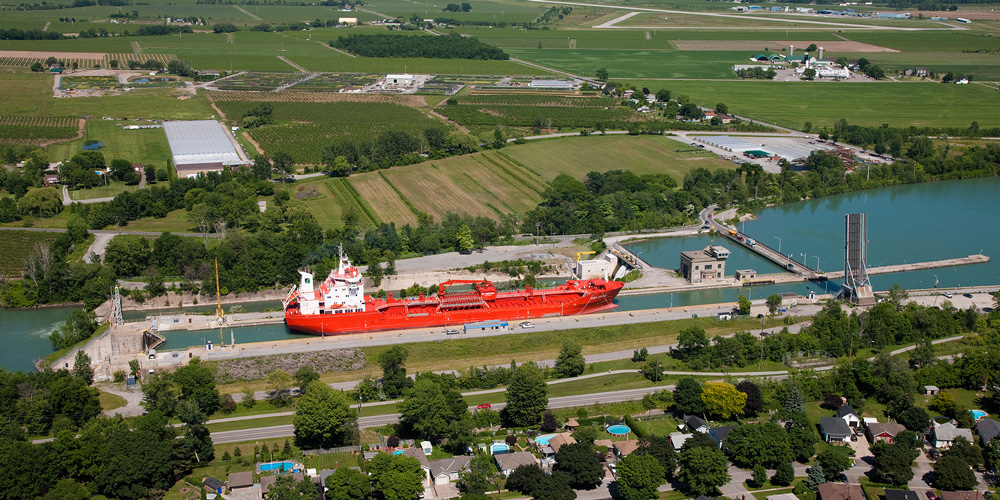#2 – General Notice
March 28, 2001
GENERAL NOTICE
This notice cancels and supersedes all previous Seaway Notices and Regional Notices to Shipping issued prior to December 31, 2000.
1. EASTERN STANDARD TIME/DAYLIGHT SAVING TIME
The Seaway entities will be operating on Eastern Standard Time from the opening of the navigation season until 0200 hours on April 1, 2001, at which time Eastern Daylight Saving Time will become effective. At 0200 hours on October 28, 2001, the operating time will revert to Eastern Standard Time.
2. SEAWAY DRAFTS
Montreal-Lake Ontario Section
As of 0001 hour April 15, the maximum permissible draft of 79.2 decimetres (26’0″) in the Montreal-Lake Ontario section of the Seaway will be increased to 80.0 decimetres (26’3″).
This draft will remain in effect until December 15 or until such time as changing water levels necessitate a draft reduction, whichever occurs first.
Welland Canal
The maximum permissible draft in the Welland Canal will be 80.0 decimetres (26’3″) for the duration of the navigation season, unless changing water levels on Lake Ontario necessitate a draft reduction.
It is the responsibility of the master to ensure that the permissible drafts are not exceeded. Overdraft vessels create scheduling problems and are a source of delay to users, especially if discharge of cargo is required.
During hot weather, the masters must be aware of “hogging” conditions and allow for this within the permissible draft.
3. SPEED LIMITS
The speed limits indicated in Column III, of the attached schedule of speed limits, will be in effect as of the opening of the navigation season. Vessels must operate within the established speed limits. A speed enforcement program will be carried out throughout the navigation season.
4. CHANGE IN LOCK OPERATING PROCEDURE
With the start of this navigation season, the program for installing lock wall controls at SLSMC locks is complete. Changes in procedures if required will be communicated in a separate notice.
At the U.S. locks 5 and 6, lock wall controls are in place to expedite downbound lockages.
5. VISIBILITY FROM THE WHEELHOUSE
Mariners are reminded of the importance of having good visibility from the wheelhouse when navigating in confined waters, particularly at night.
Obstructions to forward visibility must be avoided; whenever possible deck cargo, derricks or cranes are to be stowed, and the vessel is to be trimmed in such a manner as to provide optimum forward visibility from the conning position.
6. VESSEL EQUIPMENT
Accidents and potentially serious incidents have occurred due to malfunctions of essential equipment and, sometimes, to the failure of ship personnel to understand their equipment. Mariners are reminded that:
a) All commercial vessels are required to carry the latest charts and marine publications required for their Seaway transit and to maintain them corrected up to date;
b) The steering gear must be maintained in the best possible condition and is to be operated to give maximum steering efficiency. All watchkeeping officers and helmsmen must be fully conversant with backup systems available and know how to change over to them in an emergency. It is also essential that a well-rested and competent helmsman be on duty at all times throughout the transit;
c) Generators that supply power to winches and/or bow thrusters must be operating and on line at all times. When automatic start emergency standby equipment is not available, watchkeeping engineers must be fully conversant with emergency changeover;
d) Wrong-way propeller alarms, wrong-way pitch alarms and engine interlocks are essential safety devices that must be fully operational at all times during transit. It is important that a regular testing procedure, to verify the functioning of these installations, be established on board the vessel;
e) In the interest of safety, it is essential that Part VII Sections 81, 84 and 85 of the Seaway Handbook, “Reporting of Accidents, Impairment or other Hazards by Vessels Transiting or Intending to Transit the Seaway” be strictly adhered to;
f) Every vessel transiting between CIP 2 and Tibbetts Point, and CIP 15 and CIP 16 shall man the propulsion machinery of the vessel with qualified personnel in accordance with Part III Section 35 of the Seaway Handbook;
g) Ships using synthetic lines, in accordance with Part I Section 10 of the Seaway Handbook, shall not use nylon since its high elasticity can produce an extremely dangerous whipping effect if it breaks under stress.
h) Mooring equipment is in good working condition and movable parts, such as pedestal rollers, fairleads, etc are free to move as designed.
7. MOORING AND CASTING OFF IN LOCKS
Masters of vessels transiting the Seaway are advised that they must have sufficient competent crew members on board to properly handle the mooring lines and winches during the lockage operation. Inadequately trained seamen are not to be assigned to locking through duties.
It is important that moorings be rigged in accordance with Seaway Handbook and that instructions provided on the vessel’s Ship Inspection Report be adhered to (page 1 of the inspection report should be posted on the bridge and available for Masters/Pilots use). Masters must ensure that crew members are alert and attentive to all phases of the lockage procedure since the improper operation of mooring winches and the careless handling of mooring lines can result in serious injury to lock and shipboard personnel.
Masters are required to note the following practices:
a) During downbound lockages, release the tension of the mooring lines quickly at castoff;
b) Following the castoff signal, do not take in mooring lines prematurely; in the downbound direction, wait for the eye of the mooring wire to come over the coping before starting to take in the mooring wire;
c) Ensure that lines are coiled properly on the winch drums to avoid pinching and backlash;
d) Ensure that the slack of mooring wires is taken up only after the appropriate signal has been received from the lock crew during the initial mooring of the vessel. Thereafter, the proper tensioning of the lines during the lock fill or dump operation is the responsibility of the vessel crew;
e) Vessels are required to maintain their position in the lock during the raising and lowering operations. Winches or hand-held mooring lines shall be properly attended to avoid the necessity of engine or thruster manoeuvres during the locking operation. Care must be taken to ensure the vessel does not back up past the “STOP” sign at the stern of the vessel when preparing to depart the lock after raising or lowering;
f) Mariners are reminded that at the Eisenhower and Snell Locks, a four (4) person lockage procedure is normally in operation. At times, circumstances will exist where a three (3) person lining procedure would be instituted. Mariners will be advised as soon as possible, prior to utilizing the three (3) person procedure. Mariners are requested not to start ahead until the horn is sounded. This will give the linehandlers sufficient time to open gates and raise ship arrestors, then come back on the wall and cast off mooring lines;
g) Mariners are advised that the white light located at either end of a lock and which is activated when the end of the lock is fully open is not to be used as a signal to cast off. (These lights serve only as indicators for lock wall personnel).
The vessel is to remain secured until the Seaway officer in charge of the mooring operation gives castoff instructions. When a vessel is instructed to cast off, the mooring lines are to be slackened and the Master must ensure that they have all been cast off and clear of the bollards before commencing to heave the lines inboard.
The vessel must not exit the lock at such a speed that the mooring lines are not completely inboard before passing the lock gates. Failure to do so can result in injuries to personnel and damages to both Seaway and shipboard installations.
h) In Canadian locks, the stern lines of an upbound vessel in Locks 1 to 4, Montreal-Lake Ontario section, and 1 to 7, Welland Canal, will be secured first, when requested by the Master through the appropriate Traffic Control Centre, provided the following applies:
i) The overall length of the vessel is 185 metres or less, regardless of the beam;
ii) The overall length of the vessel is greater than 185 metres, but the beam is 20 metres or less.
8. OVERALL VESSEL DIMENSIONS
a) In recent years the design of the superstructure of vessels with machinery and accommodations aft has changed considerably and has generally resulted in an increase in the overall size of the afterhousing. As a result, the bridge wings, antenna masts and, in some cases, the samson posts or store cranes are outside the limits of the block diagram in Appendix 1 of the Seaway Handbook, should the stern of the vessel override the lock walls when exiting the locks.
Masters and pilots must take this condition into consideration and exercise extreme caution when exiting locks, to ensure that the vessel is maintained in proper lock alignment until finally passed and clear of all structures.
b) The Seaway has undertaken a review of the allowable dimensions of ships that transit the waterway and relevant section of the Seaway Handbook have been changed to allow the maximum permissible dimensions as follows:
Maximum vessel beam changed from the current 23.16 metres (76 feet) to a maximum of 23.8 metres (78 feet).
NOTE – Ships with beams greater than 23.20 m may be restricted/delayed during transits of the St. Lawrence Seaway during periods of ice cover.
Maximum vessel overall length (O.A.L.) changed from the current 222.5 metres (730 feet) to a maximum of 225.5 metres (740 feet).
Certain requirements must be met by vessels greater than 222.5 metres (O.A.L.):
- Vessels must have a rounded stem bar.
- Vessels must be equipped with adequately powered self-tensioning and self-rendering winches and fairleads at an approved location.
- Adding to the O.A.L. will somewhat decrease existing margins with respect to distances to and from ship arresters. Locking of these larger vessels will require special operating procedures. These will increase the lockage time by 2 to 3 minutes.
- Mariners must comply with special mooring instructions and procedures when proceeding through the locks.
As water levels, changes in seasonal conditions and vessel design can have an impact on the ability of Seaway locks to accommodate vessels with larger dimensions, special consideration must be given in certain cases to ensure a safe and efficient transit for all users. Prior review and approval of ship plans are necessary for all vessels in excess of the current maximum dimensions before permission to transit will be granted.
For further information regarding the transit of ships with dimensions in excess of the current maximum permissible dimensions, please direct inquiries to:
Director, Marine and Operational Services
The St. Lawrence Seaway Management Corporation
202 Pitt Street
Cornwall, Ontario
Canada K6J 3P7Tel: (613) 932-5170, ext. 3211
Fax: (613) 932-5204
9. RADIO COMMUNICATIONS
a) U.S. Traffic Control Sector
Masters are hereby reminded that one Traffic Controller is assigned to both American Sectors.b) Reporting Temperatures of Swarf Cargo
Masters are reminded of the requirement for reporting temperature readings when a vessel is carrying metal trimmings, shavings, cuttings or borings in bulk. Reference is made to Part V of the Seaway Handbook, Regulation 72(3) and Schedule III, Items 1, 19, 29, 35 and 55.c) Reporting at a Calling-in Point
For reasons of safety and the scheduling of vessel traffic, it is important that all reporting of vessel locations be made when the vessel is at the actual established calling-in point.d) Security Calls
It is a requirement that all vessels that enter the American Narrows, either upbound or downbound, make a security call on Channel 13.Upbound Vessels: The security call is made at Deer Island, LT. 186
Downbound Vessels: The security call is made at Rock Island, near LT. 213.
10. DROPPING ANCHOR – LOCK APPROACHES
In several lock approaches, underwater air bubbling equipment is installed. These installations are identified on hydrographic navigation charts as well as by signs located on the approach walls. Masters are reminded that, unless there is an extreme emergency, the dropping of anchors must be avoided in these areas in order to prevent damage to this equipment.
11. LOCK APPROACH WALLS – FENDERING
In order to reduce excessive wear and associated high repair costs on wall fendering, as well as to avoid hazards to navigation, Masters are urged not to use excessive force when sliding along approach walls.
12. CAPE VINCENT ANCHORAGE
The Saint Lawrence Seaway Development Corporation, in the interest of safety, may be directing vessels that must anchor to do so between Bartlett Point and LB-245. However, no vessel will anchor west of Carleton Island unless instructed by a Seaway officer under the provision of Part III Section 27 of the Seaway Handbook.
13. AIDS TO NAVIGATION
Mariners are cautioned not to rely solely on buoys for navigational purposes. Buoys should be used only as approximate markers defining channel limits and hazards. Mariners are urged to refer to current hydrographic charts, Sailing Directions and Notices to Mariners.
14. FLOW PATTERNS
The power entities at the Moses-Saunders Power Generating Station may be conducting peaking and ponding operations whenever the flow in the upper St. Lawrence River is below 7,930 m3/s (280,000 cfs). These operations may cause some variations in the normal current patterns and velocities in the vicinity of Iroquois Lock, Copelands Cut Light 46 and downstream of Snell Lock.
15. VERTICAL CLEARANCES
Hydrographic charts have been changed to indicate the vertical clearances above chart datum. Water levels may be above chart datum and available clearances of overhead structures and cables may therefore be less than indicated on the chart. The maximum permissible height acceptable for transit of the Seaway is 35.5 metres above the vessel’s water line.
16. LOCK ENTRY
Mariners are urged to exercise caution when entering locks to avoid passing the “STOP” symbol and contacting the breast wall or ship arrestor. Such contacts can create delays to users if replacement and/or repairs are necessary.
17. CERTIFICATES OF FINANCIAL RESPONSIBILITY
The Saint Lawrence Seaway Development Corporation wishes to advise all mariners that the United States Coast Guard will not allow any vessel to transit American waters without a Certificate of Financial Responsibility (COFR) as required under the Oil Pollution Act of 1990.
All vessels will be directed to anchor if the Certificate of Financial Responsibility is not on board the vessel or recognized as having been approved by or issued by the Coast Guard. Any questions regarding COFR should be addressed directly to U.S. Coast Guard, Marine Safety Detachment, P.O. Box 728, Massena, New York 13662, telephone (315) 764-3284.
18. MAIN ENGINE FUEL CHANGEOVER
Masters are reminded the main engine must be available to manoeuvre through its full range of speeds, while in transit between CIP2 to Cape Vincent and CIP15 to CIP16. Accidents have occurred as a result of changing fuel types in confined waters.
19. TAKING STORES OR LANDING GARBAGE
Vessels permitted to take on stores or land garbage at locks must do so in a safe and expeditious manner, so as not to delay other traffic in the system. It is the Master’s responsibility to ensure there are sufficient number of ship’s crew to attend mooring lines at all times when the ship is in the lock chamber and additional crew is available to receive stores or land garbage.
The ship’s navigation bridge and VHF radios must be manned at all times.
20. ISM CODE
Seaway Ship Inspection will include verification that the operator has onboard a valid Document of Compliance, the ship’s Safety Management Certificate and a brief audit will be performed to ensure that a safety management system has been implemented onboard the ship. Ships that are required to comply with the ISM Code under the international convention, but fail to meet the requirements may be refused transit of the St. Lawrence Seaway.
21. MARINE SANITATION DEVICES
Mariners are reminded that no untreated sewage shall be discharged into the waters of the St. Lawrence Seaway and the Great Lakes. Ships equipped with marine sanitation devices approved for use on the Great Lakes by Transport Canada, the U.S. Coast Guard or IMO should be tested to ensure that the device meets the manufacturers specifications for operation. A sampling test cock must be installed between the marine sanitation device and the overboard discharge.
Vessels not equipped with approved marine sanitation devices must be equipped with holding tanks to contain sewage onboard. Capacity of the holding tanks should be sufficient for the duration of the intended round trip voyage or pump-out arrangements during the course of the Seaway/Great Lakes voyage must be established prior to transit.
Vessels equipped solely with sewage holding tanks shall keep a sewage disposal log or make an entry in the deck log of the date and location where these tanks are pumped out or otherwise voided. Proof of pump-outs may be requested by the Seaway Authorities.
Portable toilets will not be accepted for use onboard vessels in the Seaway.
22. MINIMUM CREW REQUIREMENT FOR SEAWAY
Mariners are advised that the minimum number of Certified Deck Officers to be aboard ships greater than 1000 GRT is three, Master and 2 Deck Officers. The number of Certified Engineers to be onboard ships greater than 750 kW is 2 certified engineers. The engine room must be manned at all times in Seaway waters between CIP 2 and Tibbetts Point and between CIP 15 and CIP 16.
Officers holding dual certificates cannot be considered both a Deck Officer and Engineer. The Officer can only be accepted for one position.
The Master and/or Deck Officer must be accompanied by another qualified crewmember at all times while in the wheelhouse.
Sufficient well-rested crewmembers must be available for mooring operations and other essential duties. Ship Inspectors will decide based upon the mooring arrangements of the vessel, the number of crewmembers required.
Vessels that are accepted with minimum crew must participate in the tie-up service.
If ships with minimum crew as outlined above are delayed during transit of the MLO section resulting in the crew not having the required rest periods as per STCW-95, the ship will be directed to safe anchorage until the crew has received proper rest. Captain may be requested to provide the proposed schedule to meet the rest periods as required by STCW-95 prior to start of transit.
March 28, 2001
| Column I | Column II | Column III | Column IV | |
| Item | From | To | Maximum Speed Over The Bottom (Knots) | -á |
| 1. | Upper Entrance South shore Canal | Lake St. Louis Buoy A13 | 10.5 | 10.5 |
| 2. | Lake St. Louis Buoy A13 | Lower Entrance Lower Beauharnois Lock | 16 | 16 |
| 3. | Upper Entrance Upper Beauharnois Lock | Lake St. Francis Buoy D3 |
9 (upb) 10.5 (dnb) |
9 (upb) 10.5 (dnb) |
| 4. | Lake St. Francis Buoy D3 |
Lake St. Francis Buoy D49 |
12 (upb) 13.5 (dnb) |
12 (upb) 13.5 (dnb) |
| 5. | Lake St. Francis Buoy D49 |
Snell Lock | 8.5 (upb) 10.5 (dnb) |
8 (upb) 10.5 (dnb) |
| 6. | Eisenhower Lock | Iroquois Lock | 11.5 | 10.5 |
| 7. | Iroquois Lock | McNair Island Lt. 137 | 13 | 10.5 |
| 8. | McNair Island Lt 137 | Deer Island Lt. 186 | 11.5 | 10.5 |
| 9. | Deer Island Lt. 186 | Bartlett Point Lt. 227 | 8.5 (upb) 10.5 (dnb) |
8 (upb) 10.5 (dnb) |
| 10. | Bartlett PointLt. 227 | Tibbetts Point | 13 | 10.5 |
| 11. | Junction of Canadian Middle Channel and Main Channel abreast of Ironsides Island | Open Waters between Wolfe and Howe Islands through the said Middle Channel | 9.5 | 9.5 |
| 12. | Port Robinson | Ramey’s Bend through the Welland By-Pass | 8 | 8 |
| 13. | All other canals | -á | 6 | 6 |






